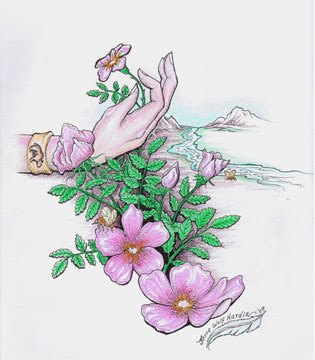
When we use the same plant day in and day out, or when we have a significant experience with that plant we start to feel a strong bond with it, similar to the relationship we might have with a lover or friend. But also very different than any human relationship, the plants may work their way into your dreamtime and inner thoughts, images or voices may appear when you least expect them. The plants are both subtle and terribly forthright,sometimes you have to work hard to earn their trust, and you may be asked to follow certain guidelines in order to be able to work with a certain plant. And sometimes you just have to ask. I recently had this experience with our native Mugwort, though I had used her dozens of times for stomach troubles, cramps, rashes and other general uses, I hadn’t yet experienced her in a powerful or personal way. Not to say I hadn’t tried, I’d slept with her, eaten her (no small task, what with that intense bitterness), spent hours at her side and had even used her in a sacred manner in the Sweat Lodge. And yet, I couldn’t clearly feel the spirit of the plant, she felt distant and removed from me, even while she assisted me each time. Finally, it occurred to me that maybe I should ask her personally for help, instead of just thanking her in advance. And you know, just after I made this request I used her for some painful cramps and suddenly could feel her loud and clear, could absolutely sense the plant in my bloodstream an psyche in the clearest and gentlest way. This experience may sound a bit silly if you’re not familiar with working with plants on a spiritual level, but once you’ve spent time with them in this context, you’ll be able to experience the inner working of the plant world for yourself ☺
Below are a few suggestions for cultivating a deep and meaningful intimacy with your plant allies.
1) Sleep with the herb under your pillow or near you, either as a whole sprig or placed in a muslin bag, NOT in plastic. Go to bed with the intent to dream of the herb, this doesn’t always work but when it does it can be a profound experience.
2) Carry the herb on your body, in a cloth or leather pouch, in a pocket or even tucked into your clothing.
3) Try to find the plant in its still living form to spend time with it. If your plant is so exotic or rare that you can’t find a living plant, consider find a local, more accessible plant. We build the best relationships with plants that live near us and share air and soil with us.
4) Talk to the plant. Yes, I said talk to the plant even if you feel like a fool while doing it. You don’t feel silly talking to your dog do you? I assure you that all plants are at least as sentient as any dog. And anyone who’s ever had a houseplant or garden knows that attentiveness and care truly affect the plant. Talking is a way to focus and express that caring energy. Of course, the effects of this may be more obvious is you’re working with a still living plant body. But lovingly harvested plant material also contains the spirit of the plant.
5) Eat the herb (if safe and sensible), many roots are tasty in soups or stirfries, leaves make lovely salads and flowers can be used to garnish almost anything.
6) Take the herb in tea or infusion form at least a few times, if just to enjoy the intimacy of knowing the full taste and texture of the plant.
7) Ingest the herb during a quiet or meditative time so that you can really BE with the plant without being distracted by outside influences.
8) Next, use the herb when you’re under stress, and in a variety of situations, to see how it helps or hinders you. Also try it when you’re attempting something creative, to see how the plant adds to the experience.
9) Use the herb consistently over a long period of time, as with most human relationships, we know someone better the more we spend time with them.
10) Although anthropomorphizing can limit your scope of vision, imagining the plant spirit in human form can also help you better understand your ally. Just remember that the plants are NOT people and while they are extremely sentient, they do not behave or feel in the same way humans do.
11) Now focus on how the plant is ~other~ than human, experience its unique green energy and non-human spirit. Is it easier to imagine the plant as a person than to confront its differentness? Even if you find it difficult to recognize or feel the ways in which the plant communicates, feels and lives in a different way than you, be persistent in your attempts to observe and participate. Then integrate this consciousness into your own perspective. As humans we tend to be remarkably self-centric, much to the detriment of our environment and plant friends, as well as to our own capacity to interact with other life.
12) After you’ve gotten to know your ally thoroughly through personal experience, read about how other cultures and people have understood and known the plant. If possible, spend time with a group or individual who is also close to the plant, this will help broaden your understanding and knowledge of your ally.
Wednesday, March 7, 2007
Twelve Tips for Cultivating Intimacy with your Plant Allies
Posted by
Oakmoss Changeling
at
8:20 PM
![]()
Labels: Green Tidbits, Therapeutics and Nutrition
Subscribe to:
Post Comments (Atom)
The Medicine Woman is glad you came...
All writings & posts (c)2007 Kiva Rose
All artwork & photographs (c) 2007 Jesse Wolf Hardin












3 comments:
I really appreciate the point you made about being careful not animorphize your allies too much. Thanks for sharing that wisdom with me.
Hi Kate! Thanks for reading, I'm glad my post was helpful to you :D
Good advice! I have had luck sitting with a plant, and making an offering. And it is important to be open to the message you receive. A plant may not give you the advice you were looking for! Sometimes the truth hurts.
GreenGoddess111
Post a Comment